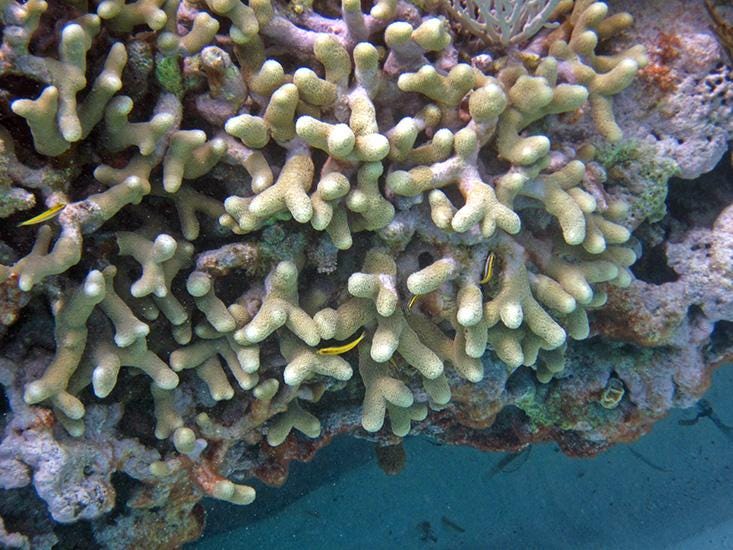Coral's Contribution: From Ocean Depths to Healing Bones
Written on
Chapter 1: The Marvel of Corals
Corals are extraordinary marine organisms. As colonies of these tiny creatures flourish, they convert the calcium present in seawater into vast limestone reefs. These impressive structures can stretch over 1,000 miles and serve as habitats for various marine life, including crabs, eels, and seahorses, making them one of nature's magnificent spectacles.
In the late 1960s, two researchers from Pennsylvania State University utilized a cutting-edge microscope to delve deeper into the fascinating world of corals. Their findings sparked a collaborative research journey from the warm waters of the South Pacific to contemporary surgical theaters, where their insights are now aiding in bone repair.

Breakthrough Recognition
In 2012, the research team received Golden Goose awards—an honor established by a U.S. Congressman to celebrate unconventional research that yields unexpected benefits. As Rodney White, one of the honorees, noted, "Most scientific advances are serendipitous, with many valuable discoveries emerging by chance."
The Journey Begins
The exploration commenced with Jon Weber, a marine geochemist focused on the carbonate structures of marine invertebrates like starfish and coral. He personally collected samples by scuba diving throughout the South Pacific, bringing them back to his Pennsylvania lab for analysis. Weber crushed these specimens and studied their chemical properties, driven by an interest in how various factors influenced the composition of marine skeletons.
During the 1960s and early 1970s, Weber published several papers addressing these inquiries. However, the introduction of a new scanning electron microscope at Penn State shifted the trajectory of his research.
A New Perspective
In the mid-1960s, Penn State became one of the first U.S. institutions to obtain a scanning electron microscope, which allowed scientists to capture detailed three-dimensional images of their samples. The coral skeletons appeared as intricate three-dimensional meshes, reminiscent of Swiss cheese.
Eugene White, a materials scientist involved in the microscope's setup, remarked, “Many questions could only be answered with this advanced equipment.” The microscope became a popular destination for researchers eager to explore its capabilities.
When Weber brought his coral specimens to the Materials Research Lab, he and White examined them under the microscope. They were astonished by the coral's unique porous structure, which bore a striking resemblance to human bone.
Understanding Bone Regeneration
Bone, although appearing hard and fragile, is a living tissue that continuously rebuilds itself. This characteristic is advantageous; when damaged, bone can regenerate. While minor fractures typically heal autonomously, larger gaps require the implementation of scaffolds or matrices to support new bone cell growth.
Bone is inherently porous, enabling doctors to repair damage by transplanting small segments of real human bone into affected areas. Such grafts are essential in modern medicine for treating injuries, congenital defects, complex fractures, and more. However, existing procedures have limitations, primarily relying on harvesting bone from the patient or utilizing cadaveric bone, both of which can present complications.
A Natural Solution
With a longstanding search for viable alternatives, scientists explored synthetic materials. Engineers had developed promising options like porous ceramics, but replicating the interconnected pore structure of natural bone remained a challenge. “Mimicking nature is incredibly difficult,” acknowledged Sridhar Komarneni, a materials scientist at Penn State.
In 1971, White invited his nephew Rodney to spend the summer in his lab. Rodney, then a student at SUNY Upstate Medical University, collaborated with his uncle and Weber, documenting coral structures. The trio increasingly suspected that corals had achieved what engineers could not: an ideal substitute for human bone.
Using a specialized pressure cooker, Della Roy transformed tropical coral into a form of artificial bone. The uniform and interconnected pores of the coral skeletons allowed for the passage of bone and blood cells, supporting the growth of new tissue.
Video Description: Explore the enchanting world of coral reefs and their role in marine ecosystems, highlighting their environmental significance.
Transforming Coral to Bone
The challenge remained: coral skeletons are made of calcium carbonate, which is absorbed by the body. "Calcium carbonate is not a viable material," Eugene White stated. The researchers needed to convert the skeleton into a more stable compound without disrupting its intricate structure.
They turned to Della Roy, a chemist in the lab, who submerged slices of Porites coral in a phosphate solution and applied heat under pressure. The phosphate replaced the carbonate, resulting in hydroxyapatite—a compound found in human bone. Remarkably, the coral's original architecture remained intact.
Rodney White then enlisted surgeons at SUNY to test the new material, now termed coralline hydroxyapatite. Initial animal trials showed promise, with new bone forming around the grafts without signs of rejection or infection.
A Lasting Impact
Subsequent studies across various animal species and eventually humans yielded similarly positive outcomes. Today, coralline hydroxyapatite is a staple in surgical reconstruction, employed in dental implants, facial reconstruction, spinal fusion, and bone repair. It has improved the lives of countless patients.
"It's a remarkable material," said Robert Bucholz, a former orthopedic surgeon involved in early human studies. "It was among the first synthetic bone graft substitutes and has proven its worth over time."
Emily Anthes is a science journalist based in Brooklyn and the author of Frankenstein’s Cat: Cuddling Up to Biotech’s Brave New Beasts. This article was commissioned by the Science Philanthropy Alliance as part of its Science to Society series, emphasizing the significance of foundational scientific research.
Chapter 2: The Future of Bone Repair
In an era where science continually evolves, the innovations derived from studying coral hold immense potential for future advancements in bone repair and regenerative medicine.
Video Description: A deep dive into the iconic Mobius's 39" Sub from Voyage to the Bottom of the Sea, exploring its design and impact on marine exploration.